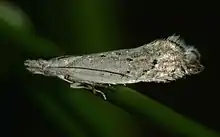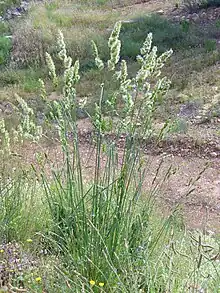| Glyphipterix achlyoessa | |
|---|---|
 | |
| Scientific classification | |
| Domain: | Eukaryota |
| Kingdom: | Animalia |
| Phylum: | Arthropoda |
| Class: | Insecta |
| Order: | Lepidoptera |
| Family: | Glyphipterigidae |
| Genus: | Glyphipterix |
| Species: | G. achlyoessa |
| Binomial name | |
| Glyphipterix achlyoessa | |
| Synonyms[2] | |
| |
Glyphipterix achlyoessa, commonly known as the cocksfoot stem borer, is a species of moth in the family Glyphipterigidae. It is endemic to New Zealand and can be found throughout the country. This species inhabits meadows and open grasslands. The larvae are hosted by species in the genus Juncus as well as by the species Dactylis glomerata. Adult moths are commonly on the wing from October to December.
Taxonomy
This species was first described by Edward Meyrick in 1880 and named Phryganostola achlyoessa.[3][2] Meyrick used material he collected at the Wellington Botanic Garden at dusk in January.[2][3] In 1915 Meyrick placed this species in the genus Glyphipteryx.[4] George Hudson discussed and illustrated this species under the name Glyphipteryx achlyoessa in 1928.[5] In 1986 the genus Glyphipteryx was judged an unjustified emendation of Glyphipterix Hübner so this species is now known as Glyphipterix achlyoessa.[6] The male holotype specimen is held at the Natural History Museum, London.[2]
Description
.jpg.webp)
.jpg.webp)
Meyrick described the species as follows:
Head and thorax whitish-grey. Palpi whitish-grey, mixed with dark fuscous, second joint beneath with a long loose prejecting fringe of hairs. Antennae dark fuscous. Abdomen elongate, dark fuscous. Legs pale ochreous-grey. Fore-wings elongate, narrow, hind-margin strongly sinuate below apex; pale whitish-grey, faintly strigulated transversely with darker; a few solitary black scales, tending to be arranged longitudinally on fold and lower median vein ; cilia whitish, with an obscure dark fuscous apical hook, basal f separated by a blackish line and dark smoky-grey. Hind-wings and cilia fuscous-grey.[3]
Distribution
This moth is endemic to New Zealand and found throughout the country.[1][7] It is regarded as being common.[5][8]
Lifecycle and behaviour
This species is on the wing from October to December.[9] When disturbed it is likely to fly a short distance before landing on a grass stem.[5]
Habitat and host plant

This species prefers to inhabit meadows and grassy open spaces.[5] It appears to prefer introduced grass species.[5] A host plant for this species is Dactylis glomerata.[10][11] Larvae have also been found boring into Juncus species.[9]
References
- 1 2 "Glyphipterix achlyoessa (Meyrick, 1880)". www.nzor.org.nz. Landcare Research New Zealand Ltd. Retrieved 2018-07-11.
- 1 2 3 4 Dugdale, J. S. (1988). "Lepidoptera-annotated catalogue, and keys to family-group taxa" (PDF). Fauna of New Zealand. 14: 1–264 – via Landcare Research New Zealand Ltd.
- 1 2 3 Meyrick, Edward (1880). "Description of Australian Micro-Lepidoptera". Proceedings of the Linnean Society of New South Wales. 5: 204–271. doi:10.5962/bhl.part.15879. Retrieved 11 July 2018 – via Biodiversity Heritage Library.
- ↑ E. Meyrick (12 July 1915). "Revision of New Zealand Tineina". Transactions and Proceedings of the New Zealand Institute. 47: 225. ISSN 1176-6158. Wikidata Q63123349.
- 1 2 3 4 5 Hudson, G. V. (1928). The Butterflies and Moths of New Zealand. Wellington: Ferguson & Osborn Ltd. p. 312. OCLC 25449322.
- ↑ Pitkin, Brian; Jenkins, Paul (5 November 2004). "Glyphipteryx - Butterflies and Moths of the World". www.nhm.ac.uk. Retrieved 2022-05-17.
- ↑ Gordon, Dennis P., ed. (2010). New Zealand inventory of biodiversity: Kingdom animalia : chaetognatha, ecdysozoa, ichnofossils. Vol. 2. p. 460. ISBN 978-1-877257-93-3. OCLC 973607714. OL 25288394M. Wikidata Q45922947.
- ↑ Alan Emmerson; Robert Hoare (28 October 2019). "Lepidoptera from Redvale, Albany, north of Auckland, New Zealand, 2004-2016: an annotated list". The Wētā. 53: 43–70. ISSN 0111-7696. Wikidata Q105342215.
- 1 2 Patrick, B.H. (1991). Insects of the Dansey ecological district (PDF). Wellington, N.Z.: Department of Conservation, New Zealand. p. 14. ISBN 0-478-01285-3. Retrieved 6 April 2019.
- ↑ "Glyphipterix achlyoessa Meyrick, 1880 Herbivore report". plant-synz.landcareresearch.co.nz. Retrieved 2019-04-06.
- ↑ Penman, D. R. (January 1978). "Biology of Euciodes suturalis (Coleoptera: Anthribidae) Infesting Cocksfoot in Canterbury". New Zealand Entomologist. 6 (4): 421–425. doi:10.1080/00779962.1978.9722309. ISSN 0077-9962 – via Taylor & Francis Online.